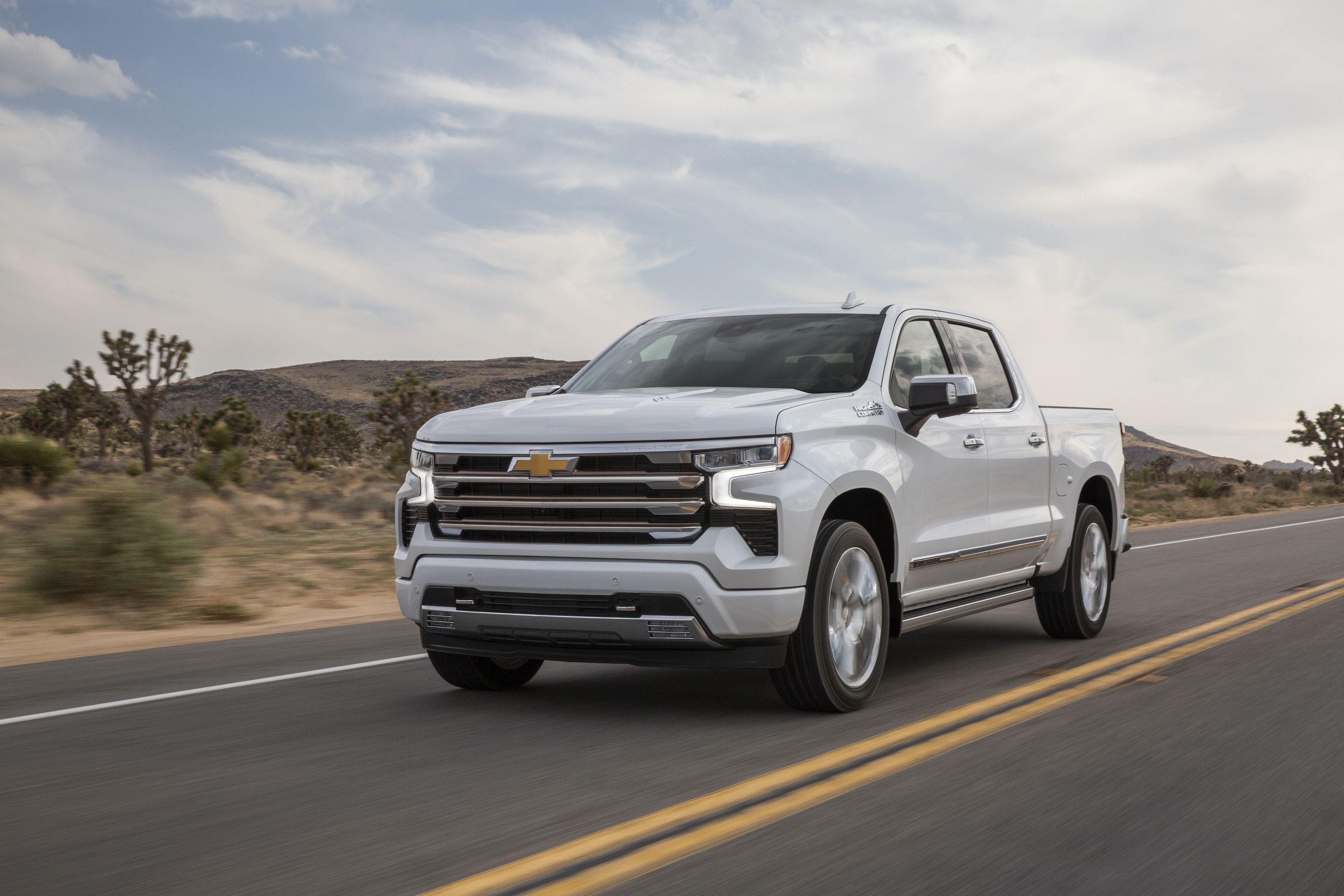Chevy Trucks New Backup Camera: A Comprehensive Guide to Enhanced Visibility and Safety pickup.truckstrend.com
The modern pickup truck is no longer just a workhorse; it’s a sophisticated mobile command center, a family hauler, and a recreational vehicle. With this evolution comes an increasing demand for advanced technology, particularly in the realm of safety and convenience. Among the most impactful innovations for truck owners is the advanced backup camera system. Chevy Trucks, a brand synonymous with durability and capability, has consistently pushed the boundaries of vehicle safety, and their new backup camera systems are a testament to this commitment.
This article delves deep into Chevy’s cutting-edge backup camera technology, exploring its features, benefits, practical applications, and what makes it an indispensable tool for today’s truck owner. From navigating tight parking spots to effortlessly hitching a trailer, these cameras are transforming the driving experience.
Chevy Trucks New Backup Camera: A Comprehensive Guide to Enhanced Visibility and Safety
The Evolution of Visibility: What’s New with Chevy’s Backup Camera?
Gone are the days when a backup camera was merely a grainy, black-and-white feed showing directly behind your vehicle. Chevy’s latest iterations of backup camera technology offer a multi-faceted approach to rearward visibility, integrating high-definition clarity with intelligent features.
At its core, the new Chevy backup camera provides a crystal-clear, high-resolution feed of the area directly behind the truck, displayed prominently on the infotainment screen. But it’s the added layers of sophistication that truly set it apart:
- High-Definition Clarity: The most noticeable upgrade is the superior image quality. Higher pixel density means clearer images, even in challenging lighting conditions, allowing drivers to discern obstacles with greater precision.
- Wider Angle Lenses: Modern Chevy cameras employ wider-angle lenses, expanding the field of view to capture more of the surroundings, significantly reducing blind spots directly behind the vehicle.
- Dynamic Guidelines: These aren’t just static lines on the screen. Dynamic guidelines curve with your steering wheel input, accurately projecting your vehicle’s trajectory, making it intuitive to back into parking spaces or around obstacles.
- Integrated Parking Assistance: Often paired with rear park assist sensors, the camera display works in conjunction with audible alerts, providing a holistic view of your immediate surroundings.
- Multiple Camera Views (Advanced Systems): For higher trims and optional packages, Chevy offers sophisticated systems like HD Surround Vision. This utilizes multiple cameras positioned around the vehicle (front, rear, side mirrors) to create a virtual 360-degree bird’s-eye view, offering unparalleled situational awareness.
- Hitch Guidance and Transparent Trailer View: Perhaps the most game-changing features for truck owners, these systems provide specific views and overlays designed to simplify trailer hitching and even virtually "see through" an attached trailer.

Unpacking the Benefits: Why This Matters for Truck Owners
The advantages of Chevy’s new backup camera systems extend far beyond mere convenience, impacting safety, efficiency, and driver confidence in significant ways.

Enhanced Safety
This is paramount. Backup cameras are proven to reduce rear-end collisions and prevent accidents involving pedestrians, children, and pets who might be out of sight in traditional mirrors. For large trucks, which inherently have larger blind spots, this technology is a critical safety net.
Improved Maneuverability
Parking a full-size pickup truck can be daunting, especially in crowded urban environments or tight parking garages. The clear, wide-angle view and dynamic guidelines make parallel parking, backing into a spot, or navigating a busy lot significantly easier and less stressful.
Effortless Trailering

For many Chevy truck owners, trailering is a core activity. The dedicated hitch guidance feature overlays a line directly to your trailer hitch ball, aligning it perfectly with the trailer coupler, often on the first try. Advanced systems can even offer a "transparent trailer" view, virtually making your trailer invisible on the screen, allowing you to see what’s directly behind it. This dramatically simplifies what was once a frustrating, multi-attempt process.
Reduced Stress and Increased Confidence
Knowing you have a clear view of your rear surroundings instills confidence, whether you’re backing out of a driveway, reversing down a boat ramp, or navigating a construction site. This reduces driver fatigue and the anxiety associated with challenging maneuvers.
Damage Prevention
Avoiding even minor bumps and scrapes can save hundreds, if not thousands, of dollars in repair costs. The camera acts as an extra set of eyes, helping you prevent accidental contact with poles, walls, other vehicles, or curbs.
How to Leverage Your Chevy Backup Camera System
Utilizing your Chevy truck’s backup camera is intuitive, but understanding its full capabilities can further enhance your driving experience.
- Basic Operation: The primary rear vision camera activates automatically when you shift the transmission into reverse (R). The image will appear on your central infotainment display.
- Understanding Dynamic Guidelines: Observe the colored lines on the screen. The fixed lines typically indicate the width of your truck. The dynamic, curving lines show the path your truck will take based on your steering wheel’s current angle. Use these to guide your turns precisely.
- Switching Views (If Applicable): If your truck is equipped with HD Surround Vision or other multi-camera systems, you’ll often see icons on the touchscreen that allow you to switch between different camera views (e.g., overhead, front, side, or specific trailer views).
- Utilizing Hitch Guidance: When hitching a trailer, the system provides a specific view with a center line aligning with your hitch ball. Back up slowly, using this line to guide you directly to the trailer coupler. Some systems even offer a zoomed-in view for pinpoint accuracy.
- Keeping the Lens Clean: Periodically check the camera lens, usually located near the tailgate handle or license plate light. Dirt, mud, snow, or water spray can obscure the view. Use a soft, damp cloth to gently clean it. Avoid abrasive cleaners or harsh scrubbing.
Important Considerations and Advanced Features
Chevy’s commitment to comprehensive safety goes beyond the basic backup camera, integrating it into a larger ecosystem of driver-assist technologies.
- Integration with Driver-Assist Systems: The backup camera often works in tandem with features like Rear Cross Traffic Alert (which warns you of vehicles approaching from the sides when backing up) and Rear Park Assist (ultrasonic sensors that detect nearby objects and provide audible alerts).
- High-Definition Surround Vision: This premium feature provides a composite, 360-degree overhead view of your vehicle and its immediate surroundings. It’s invaluable for parking in tight spaces, navigating crowded areas, or simply getting a complete picture before moving.
- Transparent Trailer View: Available on select models with the Advanced Trailering System, this innovative feature uses a camera on the rear of the truck and an optional accessory camera mounted on the back of the trailer. The system stitches these views together, effectively making the trailer "disappear" on the screen, allowing the driver to see traffic and obstacles directly behind the trailer.
- Software Updates: Like any advanced electronic system, your truck’s infotainment and camera software may receive updates. Ensure your vehicle’s software is current by checking with your dealership or via over-the-air updates if available, to ensure optimal performance and access to the latest features.
- Environmental Factors: While modern cameras perform well in various conditions, extreme low light, heavy rain, thick fog, or direct sunlight can still affect image clarity. Always use your mirrors and direct observation in conjunction with the camera.
Tips for Maximizing Your Backup Camera’s Potential
Even with advanced technology, good driving habits remain essential.
- Always Perform a Visual Check: Before backing up, always do a quick walk-around of your truck. Children, pets, or small objects can be in blind spots or too close to the vehicle for the camera to register immediately.
- Clean the Lens Regularly: As mentioned, a dirty lens is a useless lens. Make it a habit to wipe it clean, especially after off-road excursions or during inclement weather.
- Use Mirrors in Conjunction: The camera is a fantastic aid, but it doesn’t replace your side mirrors or rearview mirror. Use all available tools for a comprehensive view of your surroundings.
- Practice in a Safe Environment: If you’re new to using a backup camera or its advanced features, practice in an empty parking lot to get a feel for the different views and dynamic guidelines.
- Understand Limitations: Be aware that camera views can sometimes have a slight "fisheye" distortion, and objects may appear farther away than they actually are. Use your judgment and other aids.
Potential Challenges and Solutions
While highly reliable, no technology is entirely foolproof. Here are some common challenges and their solutions:
- Dirty or Obscured Lens:
- Solution: Regularly clean the camera lens with a soft, damp cloth. In snowy or icy conditions, ensure snow/ice is cleared from the lens.
- Glare or Direct Sunlight:
- Solution: While cameras have improved dynamic range, direct sun can still cause glare. Adjust the screen’s brightness/contrast if possible, or try to position the vehicle to minimize direct sunlight on the lens. Always rely on mirrors and direct observation.
- Low Light Performance:
- Solution: Modern cameras have better low-light sensitivity, but extreme darkness will still limit visibility. Rely more on your truck’s reverse lights and ambient lighting. If trailering, ensure your trailer lights are functioning.
- System Glitches or Blank Screen:
- Solution: First, try turning the vehicle off and on again. If the issue persists, check your owner’s manual for troubleshooting steps. It might be a fuse, a loose connection, or a software issue requiring a dealer visit.
- Cost of Replacement/Upgrade:
- Solution: If a camera is damaged, replacement costs can vary significantly. Often, it’s covered by insurance if part of a collision. Upgrading older trucks to a factory-level system can be complex and expensive; aftermarket solutions might be more feasible.
Chevy Trucks Backup Camera System: Price Information
It’s important to note that Chevy’s backup camera systems are typically integrated as standard equipment or part of specific trim levels and optional packages, rather than being sold as standalone accessories for new trucks. The pricing below reflects how these features are generally offered.
| Feature/System | Availability | Typical Cost Range (MSRP) | Notes |
|---|---|---|---|
| Standard Rear Vision Camera | Included as standard equipment on virtually all new Chevy trucks (e.g., Silverado WT, Custom, LT, etc.). | N/A (Included with vehicle purchase) | Provides a clear, basic rear view with static or dynamic guidelines. Essential safety feature. |
| HD Rear Vision Camera | Standard on most mid-to-higher trims (e.g., Silverado LT, RST, LTZ, High Country) and often available on lower trims as an upgrade. | N/A (Standard on higher trims, minor cost difference if part of a package upgrade) | Offers a sharper, higher-definition image compared to the base camera, often with wider viewing angles and dynamic guidelines. |
| HD Surround Vision | Optional on higher trims (e.g., Silverado LTZ, High Country) or as part of advanced safety/technology packages. | $1,000 – $2,500 (as part of a package) | Provides a comprehensive 360-degree bird’s-eye view using multiple cameras. Invaluable for tight parking and maneuverability. Often bundled with Rear Pedestrian Alert and other parking aids. |
| Transparent Trailer View | Optional, typically part of an Advanced Trailering Package or Technology Package on higher trims. | $500 – $1,500 (as part of a package) | This feature requires an additional accessory camera mounted on the rear of the trailer to achieve the "transparent" effect. The package itself includes other trailering enhancements. |
| Auxiliary Trailer Camera | Dealer-installed accessory, or part of the Transparent Trailer View setup. | $300 – $600 (for the accessory camera itself) | Provides an additional camera view, often mounted inside or on the back of the trailer, displayed on the truck’s infotainment screen. Useful for monitoring cargo or the road behind the trailer. |
Note: Prices are estimates and can vary significantly based on vehicle model, trim level, package contents, dealer options, and current incentives. Always consult an official Chevrolet dealer for the most accurate and up-to-date pricing information.
Frequently Asked Questions (FAQ) about Chevy Trucks New Backup Camera
Q1: Is the backup camera standard on all new Chevy trucks?
A1: Yes, a rear vision camera is standard on virtually all new Chevy trucks due to federal regulations. Higher-definition or multi-view systems (like HD Surround Vision) are often standard on higher trims or available as optional packages.
Q2: Can I add an advanced backup camera system to an older Chevy truck?
A2: While you can install aftermarket backup cameras, integrating a full factory-level system like HD Surround Vision or Transparent Trailer View into an older truck is typically not feasible or cost-prohibitive due to the complex wiring, software integration, and multiple camera requirements. Aftermarket solutions offer basic backup camera functionality.
Q3: How do I clean the backup camera lens?
A3: Gently wipe the lens with a soft, damp cloth. Avoid abrasive cleaners or strong chemicals, as they can damage the lens coating.
Q4: Does the backup camera work in the dark?
A4: Modern Chevy backup cameras have improved low-light capabilities. They utilize the truck’s reverse lights to illuminate the area. However, in extremely dark conditions with no ambient light, visibility will still be limited.
Q5: What should I do if my backup camera screen is blank or not working?
A5: First, try turning the vehicle off and on again. Check if the lens is clean and unobstructed. If the problem persists, consult your owner’s manual for troubleshooting steps or contact your Chevy dealership for diagnosis, as it could be a fuse, wiring issue, or software glitch.
Q6: Does the backup camera replace my side mirrors?
A6: Absolutely not. The backup camera is an aid to enhance visibility, but it does not replace the need to use your side mirrors and physically turn your head to check your surroundings. Always use all available tools for comprehensive situational awareness.
Q7: What’s the difference between "HD Rear Vision Camera" and "HD Surround Vision"?
A7: The HD Rear Vision Camera provides a high-definition view of the area directly behind your truck. HD Surround Vision is a more advanced system that uses multiple cameras around the vehicle to stitch together a virtual 360-degree "bird’s-eye" overhead view, giving you a complete picture of your immediate surroundings from above.
Conclusion
Chevy Trucks’ new backup camera systems represent a significant leap forward in vehicle safety, convenience, and capability. From their crystal-clear resolution and dynamic guidelines to advanced features like HD Surround Vision and Transparent Trailer View, these technologies empower truck owners with unparalleled visibility and control. They transform challenging maneuvers into simple tasks, reduce the risk of accidents, and instill greater confidence behind the wheel. As technology continues to evolve, Chevy remains at the forefront, ensuring that their trucks are not just powerful and reliable, but also among the safest and most intuitive vehicles on the road. For the modern truck owner, the advanced backup camera is no longer a luxury, but an indispensable tool that redefines the driving experience.



